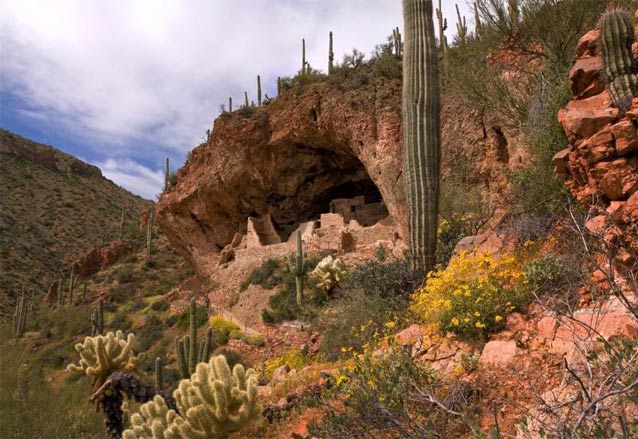Between A.D. 1250 and 1450, the Salado people influenced a large number of cultural groups within the southwestern United States through their iconographic pottery designs. The spread of the Salado culture became known as the Salado Phenomenon.

NPS
The distribution of Salado polychrome pottery encompasses a 130,000-square kilometer (more than 50,000 square miles) area in central Arizona, southwest New Mexico, and the northern Mexican states of Sonora and Chihuahua (Clarke 2001; Crown 1994). Despite the great influence of the Salado culture, archeologists continue to debate the Salado Phenomenon.
What Does Salado Mean?
The term Salado comes from the Spanish name Rio Salado, or the Salt River, that runs from the White Mountains in eastern Arizona through the Tonto Basin to its confluence with the Gila River in central Arizona (Houk 1992). The term Salado, when used in reference to southwestern archeology, can have three different meanings:
- A prehistoric cultural group living in the Tonto Basin from A.D. 1250-1450.
- Particular types of artifacts and architecture found in southern Arizona and northern Mexico.
- A prehistoric religious belief system or “cult” (Crown 1994).
Here we reference the first definition for Salado, which was put forth in 1930 by Harold and Winifred Gladwin of the Gila Pueblo Archeological Foundation in Globe, Arizona. The Gladwins defined the Salado as a cultural group by stating:
“Salado is the name suggested to cover the remains of the people who colonized the Upper Salt River drainage, and who developed various specialized features in the region adjacent to Roosevelt Lake” (Gladwin and Gladwin 1930:3).
The distinct features to which the Gladwins referred included multistoried adobe and masonry structures, cliff dwellings, compound or defensive walls, polychrome pottery, polished redwares, black-on-white and corrugated pottery, sheet trash and storage pits, and primary inhumation (burial) of the dead (Gladwin 1957:264). Because of these cultural characteristics, the Gladwins proposed that the Salado people were Puebloans who moved southwest from the upper Little Colorado River area around A.D. 1000, with a second migration from the Four Corners region bringing the Puebloan architecture and Gila polychrome ware influence (Clarke 2001).
“An inferred migration of puebloan peoples loomed large in the first models advanded by archaeologists to account... for the development of the Salado concept. As more data accumulated, researchers realized that many of the... artifacts and architecture...previously attributed to outsiders were actually the result of long-term, in situ development” (Lyons and Linsday 2006:33).
Today, the Salado cultural phenomenon of the Tonto Basin is seen as the result of both migration and in situ development, but in a much more sophisticated way than was proposed in the 1930s. The current view of Salado development suggests that the multi-cultural population base in the Tonto Basin and surrounding area derived not only from northern Puebloan people and the local Archaic/Early Agricultural tradition, but also from the adjacent Hohokam and Mogollon territories. This interpretation of Salado origins is supported by evidence from physical anthropology and ceramic analyses indicating population movements and ethnic co-residence were the norm for Salado people.
Part of a series of articles titled Salado Overview.
Next: Tonto Basin Salado
Last updated: August 17, 2015
